
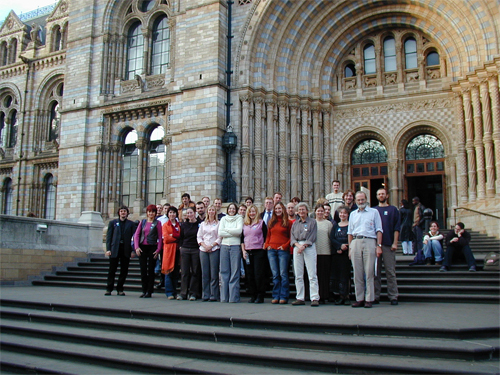
Appropriately, our main photograph (above) features
the young researchers from Europe who took part in the 6th annual Forum.
Representing the future of malacology, they stand in front of the Natural
History Museum, which has always provided steady support for The Society
and its aims. The event was again organised by Alex Ball, with assistance
of young researchers from the Museum, and The Society contributed towards
the travel costs of several participants. Hugh Jones generously donated
a large collection of the Journal of Molluscan Studies and other reprints
for distribution. An application form for this year’s Forum in
early November is available from The Society’s website. Abstracts
of the presentations follow.
ABSTRACTS
in alphabetical order of first author:
Background
matching in Littorinids: testing selection
Katie Lawson Cruickshanks
Biodiversity and Ecology Division, School of Biological Sciences,
University of Southampton, Bassett Crescent East, Southampton, SO16
7PX. Email: Klc...@soton.ac.uk
Numerous studies have investigated the adaptive significance of colour
polymorphisms in molluscs in relation to crypsis. For marine molluscs,
visual selection by fish has been shown to act on Littorina fabalis
(Reimchen, 1974). Generally, all previous classifications of colour
polymorphisms in intertidal snails have been based on the human perception
of colour. However, the assumption that predators of these molluscs
receive the same visual signals as humans is fundamentally flawed
(Hart, 2001).
A series of predation experiments were conducted under laboratory
conditions to test the role of predators in possibly maintaining the
colour polymorphism. Combinations of different colour morphs of L.
fabalis were presented to blennies, Lipophrys pholis, under two different
light regimes which made the two morphs appear conspicuous in turn.
The brown reticulata morph, which was conspicuous when light was transmitted
through the algal background, was taken preferentially to the yellow
citrina morph under transmitted light conditions. However, when light
was reflected from the algae, citrina was not significantly preferred
to reticulata.
Spectroradiometry was used to test for any correlation between the
coloration of the snails and backgrounds. Results of spectra-analysis
models have not yet been analysed but may eventually explain the choices
made by the fish.
Fig:
Blenny approaching prey under reflected light conditions.
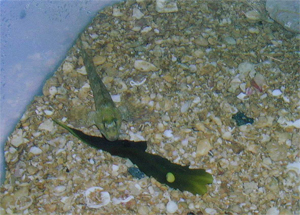
Influence
of slug defense mechanisms on food preferences of their predators
from the carabidae family
Pavel Foltan
Faculty of Biological Sciences, University of South Bohemia, Branisovska
31, CZ 37005, Czech Republic
Two-choice experiments on food preferences of a generalised predator
Pterostichus melanarius and five species of slug prey were conducted
in the laboratory. Different preferences of P. melanarius amongst
five slug species are described and interpreted as outcomes of differing
species-specific defence mechanisms of slugs, while influences of
hunger level, temperature, day/light period, condition of slugs and
beetles, weights of slugs and beetles and the sex of beetles were
controlled experimentally or statistically. Slugs were preferred in
the following order (from the most preferred): Deroceras reticulatum,
Malacolimax tenellus, Lehmania marginata, Arion distinctus and A.
subfuscus. Efficiency of slugs’ species-specific defence mechanisms
reflected their phylogeny. Defence mechanisms of slugs from Arionoidea
superfamily were significantly more efficient in deterring an attack
of non-specialised ground beetles than the defence mechanisms of slugs
from Limacoidea superfamily. P. melanarius significantly preferred
Agriolimacidae to Limacidae and Limacidae to Arionidae. Slug species
was the strongest factor influencing food preference of P. melanarius
amongst slug prey, but weight of slugs also had a significant effect.
Weight and sex of P. melanarius had no impact on its food preference.
The
"Killer Slug" taking over Sweden: Species invasion from
the front row
Jan Hagnell
Göteborg university, Department of Zoology, Box 463, SE-405 30
Göteborg, Sweden. jan....@zool.gu.se
The invasion and spread of the Iberian Forest Slug Arion lusitanicus
(Mabille) in Sweden over the last decade has generated great public
and media interest. The big question is, of course, how to get rid
of this unwanted garden pest.
At the institution of Zoology at Göteborg university we work
with the morphological, ecological and physiological impact of this
recent immigrant. We have here a great opportunity to study over time
an alien species in its new environment and how it interacts with
our domestic species, primarily Arion ater.
Parallel to this, we work on the pest control aspect of the issue.
In laboratory and field tests we evaluate a wide array of substances
and control methods with the aim of finding cheap and easy-to-use
solutions which are not harmful to the environment.
Acicula
parcelineata (Clessin, 1911) – New fossil molluscan species
of the Czech Republic
Jaroslav Hlavac
Institute of Geology Academy of Sciences of the Czech Republic,
Laboratory of Environmental Geology, Rozvojová 135, CZ-165
02 Praha 6, Czech Republic. jhla...@gli.cas.cz
In the western part of flysch West Carpathians in Vsetín Upland
(Vsetínská hornatina), Czech Republic, a Holocene calcareous
tufa cascade was studied from the viewpoint of lithology and malacozoology
in order to explain the conditions of palaeoenvironmental development.
A rich molluscan assemblage was discovered in a relatively thin (0.8
m) tufa cascade. It consists of some important species related to
malacostratigraphy, ecology and zoogeography. The most important discovery
is the find of the prosobranch Acicula parcelineata, the first fossil
record in the Czech Republic. The fossil malacocoenosis with the occurrence
of A. parcelineata and other index species enables the tufa horizon
to be stratified to the Holocene climatic optimum – Atlantic
and Epiatlantic, indicating the fully developed woodland habitats
surrounding the tufa deposit. The site is located in a region with
no previous finds of fossil molluscan assemblages.
Classification
of the western carpathian spring fens based on mollusc communities
Michal Horsak
Department of Zoology and Ecology, Faculty of Science, Masaryk University,
Kotlárská 2, CZ-61137 Brno, Czech Republic. hor...@sci.muni.cz
Mollusc communities were investigated at 48 spring fens situated in
the borderland between the Czech Republic and Slovakia in 1997-2000.
In each site,a sample of 12 litres was collected. The purpose of this
study was to test whether the gradient from mineral-poor to mineral-rich
fens is reflected in the composition and species richness of mollusc
communities. Altogether, 57 mollusc species were found; of these,
51 were terrestrial and 6 aquatic (4 snails and 2 bivalves). A cluster
analysis of mollusc communities separated the fens studied into five
basic clusters which accord well with the results of detrended correspondence
analysis (DCA). These clusters are arranged along the 1st DCA axis
following the poor-rich trophic gradient.
The
Impact of Human Presence on Malacocenoses, studied in the Novohradské
hory Mountains
(South Bohemia, Czech Republic)
Magda Hrabakova
Department of Zoology, Faculty of Science, Charles University, Vinicná
7, CZ-128 44 Praha 2, Czech Republic. magd...@seznam.cz
Preparation of a catalogue of molluscs in the Czech republic is just
running. Therefore, data from the Novohradské hory Mountains
needed to be completed. The faunistic studies have been finished.
Since 1999, eighty-one mollusc species have been found. This represents
about 34% of the whole Czech republic mollusc fauna.
The occurrence of several Carpathian and Alpine species supports the
hypothesis about the influence of both of these regions on the fauna
of the South Bohemia.
The impact of the human presence was studied by comparing the malacocenoses
of primeval forests with those of old abandoned villages. Examination
of many environmental variables proved human presence and quantity
of nutrients to be the most important factors.
While almost all natural environment was damaged by the planting of
unoriginal spruce forests, the enriched localities of the abandoned
villages serve as mollusc refuges. The majority of the original species
can survive there in places enriched by nutrients (from organic litter)
and calcium (mortar from walls).
Ruins
of medieval castles as refuges of interesting land snails in the landscape
Lucie Jurickova
Department of Zoology, Faculty of Science, Charles University, Vinicná
7, CZ-128 44 Praha 2, Czech Republic. toma...@tiscali.cz
The ruins of castles have become very specific habitats. They have
locally enriched the substratum with lime, and their disintegrated
walls have changed into artificial scree. The space of the ruins thus
constitutes a very diverse habitat. Data from 114 Czech castles were
processed in the programs STATISTICA and CANOCO. The model shows especially
the influence of phytogeographic areas (mid-European zonal vegetation,
mountain vegetation, temophilous vegetation), the stage of the ruin,
the century of desolation and castle isolation on species variability.
The snail communities inhabiting the ruins of castles reached the
highest species richness. The ruins offer favourable habitat conditions
for rare species of snails. Ruins of castles are not only important
dominant features of a landscape, but often islands of species diversity
and refuges of rare species, especially in landscapes with acidic
soils.
Impact
of gravity on distribution of Dreissena polymorpha (Bivalvia) on artificial
substrates
Jaroslaw Kobak
Nicolaus Copernicus University, Institute of General and Molecular
Biology, Department of Invertebrate Zoology, Gagarina 9, 87-100 Torun,
Poland. jko...@biol.uni.torun.pl
Mussel recruitment on 10 x 10 cm plastic plates was studied in the
Wloclawek Dam Reservoir (the Vistula River, Poland). Juveniles aggregated
at the upper edge of vertical surfaces and along all edges of horizontal
ones. The cause of this phenomenon was neither larval selection (newly
settled plantigrades did not show this pattern) nor lower mortality
at the edge (density on 7.5 x 7.5 cm plates, with higher circumference/area
ratio, was similar). Thus, mussel distribution must have resulted
from locomotion of settled individuals. The hypothesis that mussels
on vertical plates were influenced by gravity was then tested in the
laboratory. As expected, juveniles (< 10 mm) exhibited negative
geotaxis on surfaces inclined at > 3°. This behaviour was inhibited
by light. Adults (> 10 mm) moved downward, which probably demanded
the minimum effort. Locomotion of settled individuals may be an important,
and so far underestimated, factor influencing mussel distribution.
The
systematics, phylogeny and biogeography of the family Bullidae
(Mollusca: Gastropoda: Opisthobranchia): preliminary results
Manuel Antonio E. Malaquias
Department of Zoology, The Natural History Museum, Cromwell Road,
SW 7 5 BD London, UK. man...@nhm.ac.uk
The Bullidae is a small, world-wide family of cephalaspidean gastropods
believed to comprise about 30 to 40 valid living species, of predominantly
tropical distribution, but with a few species also present in temperate
waters. These attributes make this group an excellent case study to
evaluate patterns of biogeography and evolution on a global scale.
Nevertheless, the use of Bullidae as a model requires first a comprehensive
systematic revision of the group. At present the nomenclature is confused
and incongruent, because taxonomic descriptions have been based mainly
on shells, which are extremely similar in shape and colour among species.
This project is the first attempt to incorporate all available data
and new data from shell structure, anatomy and molecular sequences
in a phylogenetic and biogeographic analysis of the family Bullidae.
The three main objectives are:
(1) to review and clarify
the taxonomy of the worldwide Bullidae, based on morphological, anatomical
and molecular data of all available living species;
(2) to construct a phylogenetic
hypothesis for the Bullidae through the use of parsimony-based cladistic
analysis of morphological characters and phylogenetic analyses of
DNA sequence data, and as a result to review the generic classification
of Bullidae; and
(3) to use the phylogeny
as a basis for hypotheses of evolutionary radiation, adaptation and
biogeography of the Bullidae.
The morphological characters investigated so far will be demonstrated
together with a preliminary evaluation of their systematic value.
Physiological
and behavioural mechanisms of winter torpor in Helix pomatia
Anna Nowakowska, Michal Caputa, Justyna Rogal Ska & Katarzyna
Wentowska
N. Copernicus University, Institute of General and Molecular Biology,
Department of Animal Physiology, Ul.Gagarina 9, 87-100 Torun, POLAND.
noa...@biol.uni.torun.pl
Overwintering in terrestrial snails is often called hibernation. We
tried to check whether the nature of winter dormancy in Helix pomatia
snails is similar to that observed in hibernating mammals, or whether
the winter torpor is a passive phenomenon evoked by low temperature.
Particular attention was paid to the influence of seasons on thermal
preference of the snails (recorded automatically in a thermal gradient
system) and on blood and organ concentrations of cryoprotectants (glycerol,
glucose).
Behavioural data show that both the entry of snails into winter torpor
and the maintenance of the torpor are passive phenomena. In contrast,
spring arousal seems to be an active process. Seasonal changes in
concentration of the cryoprotectants also provide evidence of endogenous
timing of the response.
In conclusion, overwintering in Helix pomatia is a complex physiological
phenomenon involving both exogenous and endogenous factors.
Sub-fossil
Gastropods of the ‘Bandas del Sur Formation’, Tenerife and
their palaeoecological inferences
Claire Pannell
The Gatehouse, Bonkyl Lodge, Preston, Berwickshire, TD11 3TG. clai...@earthsci.gla.ac.uk
Tenerife, a stratovolcano, was probably formed by hotspot volcanism
over a slow moving plate 12.5 mya. It has suffered extensive volcanism
in the last million years, involving at least 13 eruptions that resulted
in the collapse and subsidence of the original volcano to form the massive
caldera that is Las Cañadas. The ‘Bandas del Sur’
has been extensively studied over the last thirty years and records
some of these eruptions. Pumice fall deposits and interbedded palaeosols
retain a record of a snapshot of the biota prior to eruptions, and inferences
of the past environment and climate may be made by reference to modern
land snail ecology and supported by analysis of stable isotopes from
both fossil and modern snail shell carbonate. Results of an investigation
into the spatial distribution of modern land snails are presented also
and sub-fossil snail assemblages discussed in the light of these findings.
Measuring
the rugosity of surfaces on which snails might live
Simon Pollard
Canterbury Christ Church University College, North Holmes Road, Canterbury,
Kent CT1 1QU. swp...@cant.ac.uk
If rugosity is a component of the complex scenario that is a habitat
then it would be advantageous if it could be quantified.
Scale is always of importance when considering rugosity, especially
when attempting to give differing rugosities a quantitative value.
At the continental scale a satellite would record values that may
be kilometres apart. At regional scales, a cartographer may well use
metres. At local scales an observer is likely to use metres or mm,
but at the stand scale measurements will be made using centimetres,
millimetres or probably micrometres. The equipment used will also
vary with each scale.
Although each scale presents difficulties to the relevant observer,
possibly the most difficult to accurately measure is the stand scale,
where measurements will be very small and thus any error could be
significantly large. Many molluscs spend their entire life interacting
with substratum of varying rugosities, feeding or laying eggs. Thus
the relationship between substratum rugosity and a resident organism
might be of ecological importance.
This presentation will consider the advantages and disadvantages of
three different methods of measuring rugosity. These comprise (i)
a basic manual method of measurement, (ii) the method used on the
Laser scanning microscope (LSM) and it's related computer, (iii) a
method I have designed and am testing using the LSM. I will also introduce
Mex software applicable to Scanning Electron Microscopy.
Fig.
Forum participants view 3D display during Simon Pollard’s talk.
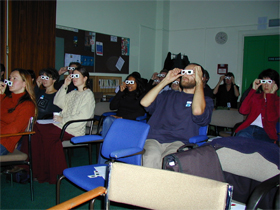
Littorina
saxatilis an example of polymorphism
Susana Isabel Rocha Ribeiro
Instituto Português de Malacologia. sirr...@hotmail.com
Littorina Férussac (1822) is one of the most thoroughly studied
genera of all marine gastropods. Littorina saxatilis Olivi (1792)
is a marine taxon showing a high degree of intraspecific variation
in shell characters. The specific status of taxa within the Littorina
saxatilis complex has been extensively debated. Initially L. saxatilis
was considered a sub-species of the “saxatilis-complex”.
Recently authors consider only three species: L. saxatilis, L. arcana
and L. compressa (=L. nigrolineata).
Most studies describe populations with big apertures and low spire
in exposed habitats and big, thick shells with big spires in sheltered
shores. All this variation was explained as a genetic response to
natural selection imposed by wave action, desiccation and predation.
Fast growth, time spent feeding, salinity and temperature also influence
shell shape as well as damaged shells. Correlations between colour
frequency and substrata suggest that colour is under visual selection
by predators. Some authors say that shells from exposed shores are
tessellated and in sheltered places tend to be fawn/orange. Shell
shape polymorphism may occur over long distances or between populations
only a few meters apart. Shell colour can also present local variation.
In the present study, the marine gastropod Littorina saxatilis was
collected from the North Wales coast and SW England in order to make
an analysis of shell characters – shape and colour - along a
horizontal (along shores) gradient. I attempted to establish a relationship
between shell characters and exposure to wave action. Results confirmed
the relationship between exposure and shape or light/dark colour of
shells. Colour pattern was related with the substrate.
Are
there endemic snails on Zanzibar?
Ben Rowson
Dept. Biodiversity & Systematic Biology, National Museums &
Galleries of Wales, Cathays Park, Cardiff CF10 3NP.
ben....@nmgw.ac.uk
The islands of Zanzibar, Pemba and Mafia were separated from coastal
Tanzania (c.30 km away) around 15,000 years ago and share most of
that region’s climate, geology, history and ecology. The islands’
biota, particularly in forest remnants, identify them as part of the
mainland’s “Coastal Forests” centre of endemism,
but c.40 endemic species and subspecies are now recognised from the
islands themselves. These are all butterflies, birds, mammals, reptiles,
or vascular plants (recent reviews record no island endemic amphibians
or diplopods). Gibbons (unpublished MS) and Taylor (1877; 1880) described
19 land snails from Zanzibar Island, most now recorded on the mainland
or synonymised with mainland species. Of another 65 land snails now
recorded from Zanzibar, all but 9 are found elsewhere (5 are known
only from the types). The taxonomy of the putative endemics is under
review, but these figures are close to the level of endemism in each
of the fragmented Coastal Forests. This is interpreted as suggesting
that the islands permit no more endemism than their forests would
were they on the mainland. In turn this may indicate that the island
and Coastal Forests were fragmented before rising sea level cut off
the islands, suggesting a minimum period of isolation required for
forest snail speciation.
Fig.
Museum specimens from Zanzibar. (Image
To Follow Soon)
The
Microstructural Deformation Mechanisms of Natural Composite Materials
DAVID SCURR AND STEVE EICHHORN
Manchester Materials Science
Centre, UMIST/University of Manchester, Grosvenor St, Manchester,
M1 7HS, UK
This study characterises the razor shell, Ensis siliqua, with respect
to density, thermogravimetry, differential thermal analysis, scanning
electron microscopy (SEM), x-ray diffraction and Raman spectroscopy.
These techniques have shown that the shell is composed almost entirely
of calcium carbonate (CaCO3), in the aragonite polymorph, with a crossed
lamellar layered microstructure. Raman spectroscopy of the shell and
standard aragonite samples have shown a direct relationship. Standard
aragonite materials show significant variations in peak intensity
related to orientation which the shell samples do not. Raman band
shifts have been observed in deformed areas of the Ensis siliqua shell,
and also during pressurisation. This characterisation study provides
insight into the relationship between microstructure and mechanical
properties of the shell, and could ultimately aid biomimicry.
Fig.
SEM of crossed lamellar layer in Ensis shell.
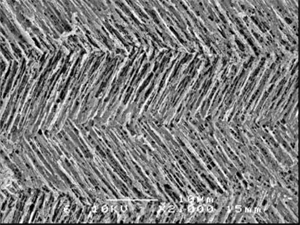
Impact
of unregulated harvesting on native oyster restoration programmes
in Strangford Lough Northern Ireland
David Smyth
School of Biology and Biochemistry, Queen’s University, Belfast
BT9 7BL. d.ro...@Queens-Belfast.ac.uk
Strangford Lough historically had a productive Ostrea edulis fishery
supporting up to 20 boats in oyster dredging although by 1903 oyster
fishing in the Lough had effectively ceased. Growth trials of oyster
spat in the Lough in the 1970’s produced favourable results
for both O. edulis and C. gigas. Between 1997 and 99 an EU-funded
project led by fishermen was started to re-establish a sustainable
native oyster fishery in the Lough. As a result, fishermen have started
to take the first harvest of native oysters from Strangford Lough
for nearly 100 years.
Surveys of oysters have been completed for 30 intertidal and 16 subtidal
sites between October 2002 and August 2003. During these surveys hand
gathering of oysters was recorded at a number of sites. The study
involved an assessment of unregulated harvesting and its likely impact
on the restoration project. Catch per unit effort studies estimate
the current unregulated harvesting to be in the region of 108 tonnes
per annum.
The
nature, functioning and ontogeny of the ciliature on mantle folds
and velum rim of ostreid larvae
Sam Stanton
Institute of Marine Sciences, School of Biological Sciences,
University of Portsmouth, Ferry Road, Portsmouth, PO4 9LY, UK. sam....@port.ac.uk
The nature, functioning and ontogeny of the ciliature on mantle folds
and velum rim of larvae of Crassostrea gigas and Ostrea edulis was
examined by still and video light microscopy, and by SEM. Complex
and ordered cilia groupings on the mantle folds of veligers and pediveligers
were revealed by SEM of specimens that had been fractured using fine
glass needles. Single cilia surrounded at the base by a ring of microvilli
occur on the mantle just anterior to the hinge in C. gigas veligers.
Information from fractured specimens is being integrated into maps
of the distribution of mantle ciliation. Some of the cilia on the
mantle rim have been observed beating in moribund larvae: in more
healthy larvae, the beating of preoral cilia obscures other cilia.
These maps already reveal both similarities with, and differences
from the mantle ciliation of pectinid larvae. SEM has revealed a previously
undescribed row of compound cilia on the velum of O. edulis beneath
the two rows of pre-oral compound cilia typical of bivalve veligers.
Differences between the velar ciliation of O. edulis and C. gigas
could relate to differences in early life history: O. edulis is a
short-term brooder, while C. gigas is a broadcast spawner.
Fig.
Larva of Crassostrea gigas
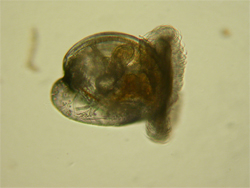
Fig. Minor pre-oral cilia on feeding groove
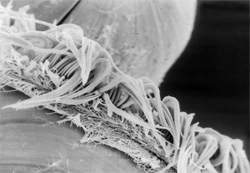
Fig. Dorsal mantle cilia bases showing microvilli
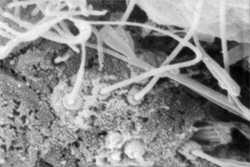
Small-scale
spatial distribution of molluscan fauna: movement into set-aside land
Colleen Wolski
School of Science and the Environment, Bath Spa University
College. aar...@wolski69.fsnet.co.uk
The study investigates molluscan distribution patterns in an eleven
year old set-aside deciduous plantation surrounded by old hedgerows.
Turf samples were taken over the plantation at 5 m intervals and live
and total molluscan numbers and species assessed. A thorough survey
of the hedges was also undertaken. It was evident that each molluscan
species demonstrated a different dispersal capability and/or tolerance
to changing conditions. The reservoir of species in the hedgerows
and the aspect of the plantation are factors that best explain the
distribution of molluscan species in the plantation at this time.
Some species demonstrated a high degree of movement from the hedgerows
to the plantation suggesting good colonisation abilities and/or suitable
conditions, for example, Cochlicopa lubrica, Vitrea contracta, Aegopinella
nitidula and Trichia hispida. Some species were restricted to the
hedgerows or near to the hedgerows suggesting either poor colonisation
ability and/or conditions in the field were not yet suitable or only
recently becoming suitable, for example, Acanthinula aculeata, Ena
obscura, Clausilia bidentata and Arianta arbustorum.
Initial
study of non-specific defence reactions of Lymnaea stagnalis (L.)
individuals, naturally parasitised with trematode larvae
Elzbieta Zbikowska
Department of Invertebrate Zoology, Institute of General
and Molecular Biology, Nicholas Copernicus University in Torun, Poland.
ezbi...@biol.uni.torun.pl
The objective of study was to determine whether snails parasitised
with trematode larvae had different thermal preferences than non–parasitised
ones, and whether parasitic infection of the snail host influenced
the morphotic composition of their hemolymph.
Snails under observations were kept in an oblong thermal gradient.
Temperatures selected by snails were automatically registered during
24 hours. Hematological study was made using the Fuchs-Rosenthal counting
camera (3.2 ?l vol.).
Lymnaea stagnalis individuals parasitised with two among four different
trematode species chose a lower temperature than non-parasitised ones.
However, only individuals which released cercariae of parasites had
different thermal preferences from the non-larvae-releasing ones.
More spectacular proved the results of the hematological study. Snails
naturally parasitised with three of the four trematode species under
study, possessed more hemocytes in 1 of hemolymph than non-parasitised
ones. All noted differences were statistically significant. It was
noticed that a low hemocyte number in the hemolymph of parasitised
snails was correlated with lower vitality of those snails.

